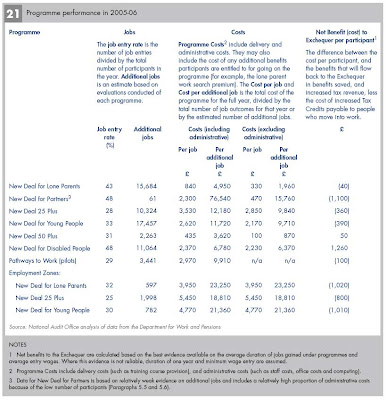How to get shameless workshy dole recipients back to work and earning their own keep is one of the oldest problems in welfare. Indeed, it was the principal driver for the Poor Law reforms of the 1830s (see this blog and James Bartholomew's outstanding Welfare State We're In for details). Of course, those reforms were later reversed, and under the entitlement culture engendered by today's Big Government, the problem is more acute than ever.
Today there are 4.2m people of working age living in workless households. The vast majority are supported by taxpayers, costing us an estimated £12.7bn pa, including £3.4bn pa on benefits for lone parents (source: NAO Report). That's equivalent to nearly 4 pence on the standard rate of income tax.
Getting these people into work is generally called Welfare to Work, although New Labour naturally branded their programme with an upbeat Newspeak title- the somehow familiar sounding New Deal.
Now, as taxpayers, we ought to be applauding the New Deal: get those people back to work and we could save a huge amount of money. The trouble is, the New Deal doesn't seem to be saving us money at all. In fact, according to the NAO's report published in July, it costs us even more than just paying the benefits.
The following table summarises the costs and benefits for each of the ten (!) separate New Deal back to work programmes. "Net fiscal benefit per participant’ estimates the cost effectiveness to the Exchequer of the programme. It is based on the cost of the programme, minus the direct benefits to the Exchequer (such as increased tax receipts and reduced benefit payments when people move into work) and the costs of any additional in-work payments such as Tax Credits" (report para 5.3):

As we can see, only two of these ten programmes end up saving us money. With all the rest, the costs of running the programmes significantly exceed the savings we make. Hardly surprising when one of these programmes has cost £76,540 per job.
Looks like we'd have been much better off without the New Deal, saving ourselves the £6bn the programme has already cost (Report figure 1).
So what's going on? On Wednesday, your correspondent attended the Public Accounts Committee meeting that tried to find out.
Appearing before the PAC were three mandarins led by the Department for Work and Pensions' Permanent Secretary Sir Leigh Lewis. But despite being given one-and-a-half hours, they were entirely unable to demonstrate the New Deal delivers taxpayer value. In fact, it became painfully clear the whole programme is another all too familiar amalgam of wishful thinking and bureaucratic treacle.
Here are some key points:
PAC question: How can we be getting taxpayer value if the costs exceed the benefits?
DWP answer: We think there must be many additional benefits which have not been quantified. Lower NHS costs, lower costs from crime,and a load of other stuff
PAC question: How can you possibly know that?
DWP answer: We've had three studies conducted by academics. We paid them and they confirmed we're right.
PAC question: How do you know your "clients" haven't simply got jobs they'd have got anyway because of the strong economy?
DWP answer: Because we say so. Trust us.
PAC question: What about churn? Surely most of these people get pushed into a low grade job for a few months, then lose it, and then have to start all over again.
DWP answer: There's absolutely no evidence to support that conclusion. Or more precisely, there's absolutely no evidence. The simple reason being we don't collect any.
PAC question: What about immigration- surely large-scale immigration must be making it much harder to place our own native workless into jobs.
DWP answer: You are falling for what our economists call the Lump of Labour fallacy. It's well known that immigration boosts the economy and so must be good for jobs. QED. (for an exposition of how most economists outside Whitehall now agree that mass immigration really does take income and jobs from native workers see this blog).
PAC question: Why have you set up such a ludicrously complicated structure? The NAO report says that in Glasgow alone the local programme involves 125 organisations and 325 individual programmes, projects and services.
DWP answer: Yes, well, this is work in progress (even though in reality some of these programmes have now been running for over a decade)
The overall conclusion is clear. The New Deal delivers shocking value for taxpayers. It is costly and ineffective, and has spawned yet another gigantic bureaucracy.
In essence, it is yet another social service. But by masquerading as a measure to boost GDP and somehow make us all better off, it is managing to deliver the worst of both worlds.
